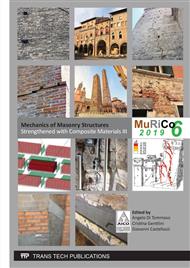[1]
Micelli, F., Cascardi, A., & Marsano, M. (2016, June). Seismic strengthening of a theatre masonry building by using active FRP wires. In Brick and Block Masonry: Proceedings of the 16th International Brick and Block Masonry Conference (pp.753-761).
DOI: 10.1201/b21889-94
Google Scholar
[2]
Cascardi, A., Dell'Anna, R., Micelli, M., Lionetto, F., Aiello, MA. And Maffezzoli, A. Reversible FRP-confinement of heritage masonry columns. Proceedings of the 9th International Conference on Fibre-Reinforced Polymer (FRP) Composites in Civil Engineering (CICE 2018) At: Paris, France.
DOI: 10.1016/j.conbuildmat.2019.07.124
Google Scholar
[3]
Maddaloni, G., Cascardi, A., Balsamo, A., Di Ludovico, M., Micelli, F., Aiello, M. A., & Prota, A. (2017). Confinement of full-scale masonry columns with FRCM systems. In Key Engineering Materials (Vol. 747, pp.374-381). Trans Tech Publications.
DOI: 10.4028/www.scientific.net/kem.747.374
Google Scholar
[4]
Minafò, G., & La Mendola, L. (2018). Experimental investigation on the effect of mortar grade on the compressive behaviour of FRCM confined masonry columns. Composites Part B: Engineering, 146, 1-12.
DOI: 10.1016/j.compositesb.2018.03.033
Google Scholar
[5]
Ombres, L., & Verre, S. (2018). Masonry columns strengthened with Steel Fabric Reinforced Cementitious Matrix (S-FRCM) jackets: Experimental and numerical analysis. Measurement, 127, 238-245.
DOI: 10.1016/j.measurement.2018.05.114
Google Scholar
[6]
Cascardi, A., Longo, F., Micelli, F., & Aiello, M. A. (2017). Compressive strength of confined column with Fiber Reinforced Mortar (FRM): New design-oriented-models. Construction and Building Materials, 156, 387-401.
DOI: 10.1016/j.conbuildmat.2017.09.004
Google Scholar
[7]
Cascardi, A., Aiello, M. A., & Triantafillou, T. (2017). Analysis-oriented model for concrete and masonry confined with fiber reinforced mortar. Materials and Structures, 50(4), 202.
DOI: 10.1617/s11527-017-1072-0
Google Scholar
[8]
Carloni, C., Mazzotti, C., Savoia, M., & Subramaniam, K. V. (2014). Confinement of Masonry Columns with PBO FRCM Composites. Key Engineering Materials, 624.
DOI: 10.4028/www.scientific.net/kem.624.644
Google Scholar
[9]
Mezrea, P. E., Yilmaz, I. A., Ispir, M., Binbir, E., Bal, I. E., & Ilki, A. (2016). External jacketing of unreinforced historical masonry piers with open-grid basalt-reinforced mortar. Journal of Composites for Construction, 21(3), 04016110.
DOI: 10.1061/(asce)cc.1943-5614.0000770
Google Scholar
[10]
Murgo, F. S., & Mazzotti, C. (2019). Masonry columns strengthened with FRCM system: Numerical and experimental evaluation. Construction and Building Materials, 202, 208-222.
DOI: 10.1016/j.conbuildmat.2018.12.211
Google Scholar
[11]
Cascardi, A., Micelli, F., & Aiello, M. A. (2018). FRCM-confined masonry columns: experimental investigation on the effect of the inorganic matrix properties. Construction and Building Materials, 186, 811-825.
DOI: 10.1016/j.conbuildmat.2018.08.020
Google Scholar
[12]
Sadrmomtazi, A., Khabaznia, M., & Tahmouresi, B. (2016). effect of organic and inorganic matrix on the behavior of FRP-wrapped concrete cylinders. Journal of Rehabilitation in Civil Engineering.
Google Scholar
[13]
ABAQUS Finite Element Code. 2014. Hibbitt, Karlsson & Sorensen, Imc, RI.
Google Scholar
[14]
G. Fortunato, M.F. Funari, P. Lonetti, Survey and seismic vulnerability assessment of the Baptistery of San Giovanni in Tumba (Italy). J Cult Herit, 26 (2017) 64-78.
DOI: 10.1016/j.culher.2017.01.010
Google Scholar
[15]
F.J. Vecchio, M.P. Collins. The modified compression-field theory for reinforced concrete elements subjected to shear. ACI Structural Journal (1986) 219-231.
DOI: 10.14359/10416
Google Scholar
[16]
G.M. Chen, J.G. Teng, J.F. Chen, Q.G. Xiao, Finite element modeling of debonding failure in FRP-strengthened RC beams: a dynamic approach, Computer and Structures 158 (2015) 167-183.
DOI: 10.1016/j.compstruc.2015.05.023
Google Scholar


